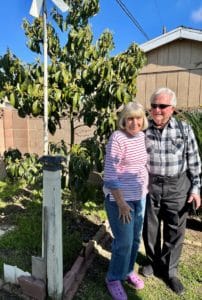Hello fellow readers, My “big kid” project is dragging on, but I haven’t given up hope. You may recall the column inspired by Cheryl of Blairstown, who I met while walking Jolee. She started avocado seeds in water as a science experiment to encourage her daycare center kids to grow interested in plants (link to story below.) Since then, a story of a magical avocado tree came to me through a dear friend; A story that inspires a lesson of encouraging growth.
Maybe the wrong end is up?
They say after six weeks, if an avocado seed doesn’t sprout, it’s a dud. Well, mine cracked, a good sign, and there’s a greenish-white alien-looking thingy emerging— perhaps the taproot? But it hasn’t progressed much in the last few weeks; I’d say it’s over eight weeks since the experiment started. I wonder if I didn’t correctly determine which end was up. You see, my seed was almost perfectly round.
The magical avocado tree produced fruit early.
One day, my college roommate and lifelong friend from California and I were chatting while she was snacking on one of her parent’s avocados. Linda shared what she knew of the tree that produced fruit far sooner than most.
Avocados grown commercially are grafted to bear fruit in three to four years but grown naturally, avocados take fifteen or more years to fruit. Linda’s folk’s tree couldn’t have been grafted; they started it from the seed of an avocado given by their neighbor.
And so, we arranged an interview with Doris and Peter to find out about their magical tree.
“When we were done eating the avocado, the seed went right in the ground,” Doris said. “If it grows, fine. If not, it’s okay too. And it did me a favor, and it grew and grew.”
And grow it did, standing twenty feet tall after only a few years.
Seeds know how to right themselves.
“Did you plant it pointy side up,” I asked?
“That’s a good question,” Doris said in her charming German accent. “I just dropped it in there.”
The good news is seeds can right themselves if planted upside down as they are geotropic meaning, the direction of growth has to do with gravity.
Peter said they harvested 35 avocados from their tree. When asked how long it took to produce fruit,
“I’d say between two and two and a half years; we had clusters of five hanging like grapes. Now we have blossoms like you would not believe.”
Why Mexicola Grande avocados are popular.
Their Mexicola Grande avocado is the most popular for home gardens as they are fast-growing to thirty feet tall and twenty feet wide. And, they are cold-hardy, tolerating freezes to eighteen degrees. Though they are grown in Zones 9 through 11, so don’t get any ideas northeasterners :^)
As the name denotes, the fruit is 15 to 25 percent larger than most. And unlike others whose skin and leaves are considered mildly toxic, Mexicola Grande’s are edible, tasting like anise. Dry leaves frequently make their way into Mexican dishes or tea said to be helpful for digestion.
What inspired Doris and Peter’s Avacado to grow so quickly?
Are you giving it any special care and feeding? I asked.
“No— We just check to make sure the squirrels don’t get to them before we do.”
I wasn’t surprised they weren’t dosing the plant with chemical fertilizers or growth hormones, knowing they respect our dear earth.
“Do you talk to your tree?”
“Yes, occasionally. I say how well he’s doing, and I’m so proud of him.”
That’s the magic right there. Maybe I haven’t been very nice to my avocado seed. To which Doris replied, “maybe it’s my German accent.”
Linda pipes in, “My mom’s words of encouragement. Look what it did for me, Mary.”
Yes indeed. We all need encouragement.
Garden Dilemmas? AskMaryStone@gmail.com (and your favorite Podcast App.)
There’s more to this story, including sound bites from the interview in the latest podcast – Encouraging the Seasons of Growth:
Link to the previous story Sprouting Avacado Seeds in Water
More about Mexicola Grande Avocado






Why would an avocado tree have small brown spots on the stem fro. The bottom to top.
Hello Juanita, I tried to dig into your brown spot dilemma to no avail. There are many leaf fungal diseases, as you likely researched. But it seems odd to be on stems. I’m sorry I couldn’t help you, and I hope your tree quickly recovers. Thank you for reading my column, Mary